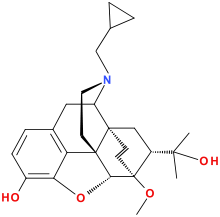Cyprenorphine
 | |
| Clinical data | |
|---|---|
| ATC code | none |
| Legal status | |
| Legal status |
|
| Identifiers | |
| |
| CAS Number |
4406-22-8 |
| PubChem (CID) | 544534 |
| ChemSpider |
16735758 |
| UNII |
1P6HEG5ZHS |
| ChEMBL | CHEMBL2106063 |
| Chemical and physical data | |
| Formula | C26H33NO4 |
| Molar mass | 423.545 g/mol |
| 3D model (Jmol) | Interactive image |
| |
| |
| (verify) | |
Cyprenorphine (M-285) is an opioid drug. It is related to more well-known opioids such as buprenorphine, which is used as an analgesic and for the treatment of opioid addiction, and diprenorphine, which is used as an antidote to reverse the effects of other opioids.
Cyprenorphine has mixed agonist–antagonist effects at opioid receptors, like those of buprenorphine. However the effects of cyprenorphine are somewhat different, as it produces pronounced dysphoric and hallucinogenic effects which limit its potential use as an analgesic.[1][2]
References
- ↑ Bentley KW, Boura ALA, Fitzgerald AE, Hardy DG, McCoubrey A, Aikman ML, Lister RE. Compounds Possessing Morphine-Antagonizing or Powerful Analgesic Effects. Nature, 1965; (206):102-103.
- ↑ Lowe G, Williams DI. Some Effects of a Hallucinogenic Compound (Cyprenorphine Hydrochloride; M 285) on the Light Reinforced Behaviour of Rats. Nature. 1969; (224):1226.
| MOR |
|
|---|---|
| DOR |
|
| KOR |
|
| NOP |
|
| Unsorted |
|
| Others |
|
See also: Peptide receptor modulators | |
This article is issued from Wikipedia - version of the 5/23/2016. The text is available under the Creative Commons Attribution/Share Alike but additional terms may apply for the media files.